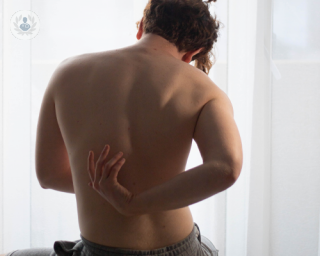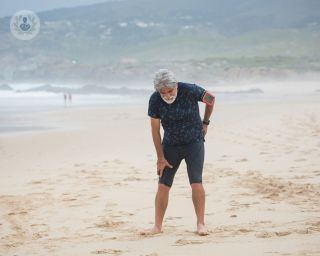What is spondylolistheis?
Spondylolisthesis is a condition affecting the spine where the vertebrae slip out of position, either forwards or backwards. In children, it mostly affects the L5 (5th lumbar vertebra) and the pelvis.
To formulate an accurate diagnosis of spondylolistheis, your doctor will examine your spinal column or will have you raise your leg up, which could cause you some discomfort or pain if you have this condition.

Prognosis
Spondylolisthesis is successfully treated with surgery in 90 per cent of cases. In more rare cases, potential complications such as a compressed nerve or loss of sensitivity to the legs may arise. Conservative treatment is successful in treating roughly 80 per cent of cases.
What are the symptoms?
Depending on how severe it is, spondylolisthesis can also be asymptomatic. The main symptom is a visible worsening of lordosis, that is, a worsening of the normal inward lordotic curvature of the lumbar of the spine.
In its more advanced stages, it could lead to kyphosis, that is, an abnormally excessive convex curvature of the spine in the thoracic and sacral regions. Other symptoms of spondylolisthesis include:
- Pain and numbness in your buttocks and thighs;
- Low back pain;
- Muscular tension and stiffness;
- Increased sensitivity in your legs and in the affected area.
How is it diagnosed?
Spondylolisthesis can be diagnosed with an X-ray scan. Given that it can be asymptomatic, this condition can also be diagnosed collaterally during an X-ray scan done to diagnose another condition.
What causes it?
It can be caused by congenital malformations, by a sudden injury or by acute trauma. Other causes include bone diseases and bone fractures caused by sports such as gymnastics or weight lifting, where the lower back is under a lot of pressure. The most common cause for adults is cartilage damage due to arthritis.
How can it be prevented?
It is not possible to prevent this condition. This is why an early detection is essential to treat it and slow down its progression. However, you can avoid other potential complications by not engaging in sports requiring excessive weight lifting and/or an excessive pressure on you back.
How is it treated?
The treatment depends on how much the vertebra has slipped. In the vast majority of cases, you will have to do some exercises to strengthen your muscles and lower back. A doctor will monitor the progression of the condition with an X-ray scan.
To prevent spondylolisthesis from getting worse, you may have to do one or more of the following:
- Using a back brace to straighten your spine;
- Medication for the pain;
- Physical therapy, focusing on stretching and strengthening exercises;
- Surgery, which will realign the vertebrae.
Spondylolisthesis
Mr Ramsey Chammaa - Orthopaedic surgery
Created on: 07-23-2015
Updated on: 10-11-2023
Edited by: Sophie Kennedy
What is spondylolistheis?
Spondylolisthesis is a condition affecting the spine where the vertebrae slip out of position, either forwards or backwards. In children, it mostly affects the L5 (5th lumbar vertebra) and the pelvis.
To formulate an accurate diagnosis of spondylolistheis, your doctor will examine your spinal column or will have you raise your leg up, which could cause you some discomfort or pain if you have this condition.

Prognosis
Spondylolisthesis is successfully treated with surgery in 90 per cent of cases. In more rare cases, potential complications such as a compressed nerve or loss of sensitivity to the legs may arise. Conservative treatment is successful in treating roughly 80 per cent of cases.
What are the symptoms?
Depending on how severe it is, spondylolisthesis can also be asymptomatic. The main symptom is a visible worsening of lordosis, that is, a worsening of the normal inward lordotic curvature of the lumbar of the spine.
In its more advanced stages, it could lead to kyphosis, that is, an abnormally excessive convex curvature of the spine in the thoracic and sacral regions. Other symptoms of spondylolisthesis include:
- Pain and numbness in your buttocks and thighs;
- Low back pain;
- Muscular tension and stiffness;
- Increased sensitivity in your legs and in the affected area.
How is it diagnosed?
Spondylolisthesis can be diagnosed with an X-ray scan. Given that it can be asymptomatic, this condition can also be diagnosed collaterally during an X-ray scan done to diagnose another condition.
What causes it?
It can be caused by congenital malformations, by a sudden injury or by acute trauma. Other causes include bone diseases and bone fractures caused by sports such as gymnastics or weight lifting, where the lower back is under a lot of pressure. The most common cause for adults is cartilage damage due to arthritis.
How can it be prevented?
It is not possible to prevent this condition. This is why an early detection is essential to treat it and slow down its progression. However, you can avoid other potential complications by not engaging in sports requiring excessive weight lifting and/or an excessive pressure on you back.
How is it treated?
The treatment depends on how much the vertebra has slipped. In the vast majority of cases, you will have to do some exercises to strengthen your muscles and lower back. A doctor will monitor the progression of the condition with an X-ray scan.
To prevent spondylolisthesis from getting worse, you may have to do one or more of the following:
- Using a back brace to straighten your spine;
- Medication for the pain;
- Physical therapy, focusing on stretching and strengthening exercises;
- Surgery, which will realign the vertebrae.


What happens if you need sciatic spinal injections?
By Mr Jaykar Panchmatia
2025-01-16
Treatment for sciatica can vary. People with chronic pain may be treated with injections. Leading consultant spine surgeon Mr Jaykar Panchmatia discusses what patients with sciatic pain can expect if spinal injections are required. See more


Disc and back pain: A neurosurgeon's perspective
By Mr Samih Hassan
2025-01-15
Disc and back pain are common conditions that can significantly impact daily activities and overall quality of life. Understanding the relationship between these conditions and neurosurgery is crucial for patients seeking effective treatment options. Leading consultant neurosurgeon Mr Samih Hassan provides comprehensive information about disc and back pain from a neurosurgical perspective in this article. See more


5 different types of spondylolisthesis
By Mr David Bell
2025-01-15
When a bone in the vertebra slips out of place it is known as a condition called spondylolisthesis. There are, however, five types of this condition and none of which should be confused for a slipped disc. Leading neurosurgeon Mr David Bell explains the differences and how it's treated. See more
Experts in Spondylolisthesis
-
Mr Stewart Tucker
Orthopaedic surgeryExpert in:
- Scoliosis
- Spondylolisthesis
- Spinal cancer
- Sciatica
- Spinal Cord Injury
- Slipped disc
-
Mr Rath Sundaram
Orthopaedic surgeryExpert in:
- Spondylolisthesis
- Spinal surgery
- Spinal stenosis
- Sciatica
- Spinal cord compression
- Back pain
-
Mr Alex Torrie
Orthopaedic surgeryExpert in:
- Spinal surgery
- Spondylolisthesis
- Sciatica
- Discectomy
- Lumbar spinal surgery
- Spinal cord compression
-
Miss Hui-Ling Kerr
Orthopaedic surgeryExpert in:
- Sciatica
- Spondylolisthesis
- Spinal surgery
- Spinal cord compression
- Back pain
- Neck pain
-
Mr Rajat Verma
Orthopaedic surgeryExpert in:
- Back pain
- Scoliosis
- Degenerative disc disease
- Sciatica
- Spinal fusion
- Spondylolisthesis
- See all

The Portland Hospital - part of HCA Healthcare
The Portland Hospital - part of HCA Healthcare
205 - 209 Great Portland St. W1W 5AH
No existe teléfono en el centro.
By using the telephone number provided by TOP DOCTORS, you automatically agree to let us use your phone number for statistical and commercial purposes. For further information, read our Privacy Policy
Top Doctors

The Wellington Hospital - part of HCA Healthcare
The Wellington Hospital - part of HCA Healthcare
Wellington Hospital South Bldg, 8A Wellington Pl, NW8 9LE
No existe teléfono en el centro.
By using the telephone number provided by TOP DOCTORS, you automatically agree to let us use your phone number for statistical and commercial purposes. For further information, read our Privacy Policy
Top Doctors

Sheffield Orthopaedics Ltd
Sheffield Orthopaedics Ltd
Claremont Hospital, 401 Sandygate Rd, Sheffield
No existe teléfono en el centro.
By using the telephone number provided by TOP DOCTORS, you automatically agree to let us use your phone number for statistical and commercial purposes. For further information, read our Privacy Policy
Top Doctors
-
The Portland Hospital - part of HCA Healthcare
205 - 209 Great Portland St. W1W 5AH, Central LondonExpert in:
- Neurological spinal surgery
- Orthopaedic spinal surgery
- Maternity care
- Pregnancy
- Scoliosis
- In vitro fertilisation (IVF)
-
The Wellington Hospital - part of HCA Healthcare
Wellington Hospital South Bldg, 8A Wellington Pl, NW8 9LE, Central LondonExpert in:
- Digestive
- Cardiology
- Orthopaedic surgery
- Orthopaedic spinal surgery
- Intensive care
- Spine
-
Sheffield Orthopaedics Ltd
Claremont Hospital, 401 Sandygate Rd, Sheffield, SheffieldExpert in:
- Hip
- Orthopaedic surgery
- Orthopaedic spinal surgery
- Shoulder and elbow
- Joint replacement
- See all
- Most viewed diseases, medical tests, and treatments
- Trigeminal neuralgia
- Alzheimer's disease
- Cluster headaches
- Tension headache
- Chronic headache
- Ulnar nerve entrapment
- Peripheral nerve block
- Peripheral neuropathy
- Joint pain
- Lumbar herniated disc








